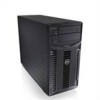Dell PowerEdge T410 Hardware Owner's Manual - Page 29
E1210 Motherboard, 3V Regulator
 |
View all Dell PowerEdge T410 manuals
Add to My Manuals
Save this manual to your list of manuals |
Page 29 highlights
Table 1-2. LCD Status Messages (continued) Code Text Causes Corrective Actions E1116 Memory Memory has exceeded Remove AC power to the disabled, temp allowable temperature and system for 10 seconds and above range. has been disabled to restart the system. Power cycle AC. prevent damage to the components. See "Troubleshooting System Cooling Problems" on page 161. If the problem persists, see "Getting Help" on page 185. E1210 Motherboard CMOS battery is missing See "Troubleshooting the battery or the voltage is outside of System Battery" on failure. Check the allowable range. page 160. battery. E1211 RAID Controller battery failure. Check battery. RAID battery is either missing, bad, or unable to recharge due to thermal issues. Reseat the RAID battery connector. See "Installing a RAID Battery" on page 120, and "Troubleshooting System Cooling Problems" on page 161. E1216 3.3V Regulator failure. Reseat PCIe cards. 3.3V voltage regulator has failed. Remove and reseat the PCIe expansion cards. If the problem persists, see "Troubleshooting Expansion Cards" on page 169. E1229 CPU # VCORE Regulator failure. Reseat CPU. Specified processor Reseat the processor(s). VCORE voltage regulator See "Troubleshooting the has failed. Processors" on page 171. If the problem persists, see "Getting Help" on page 185. About Your System 29















